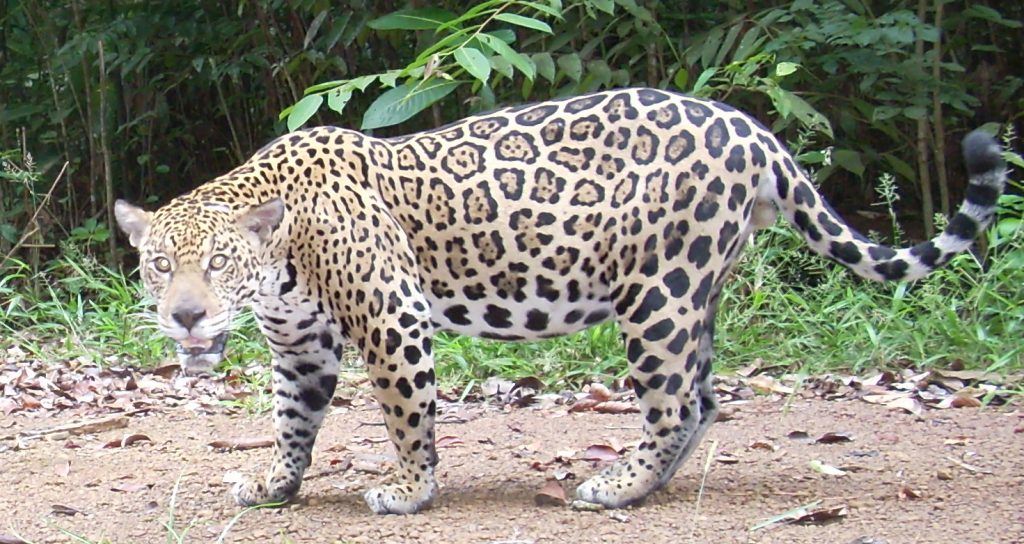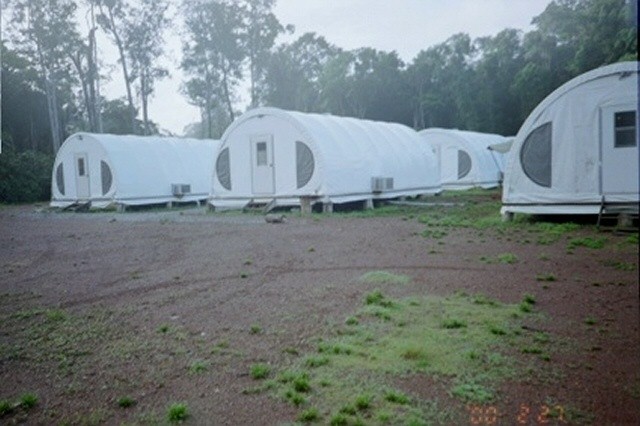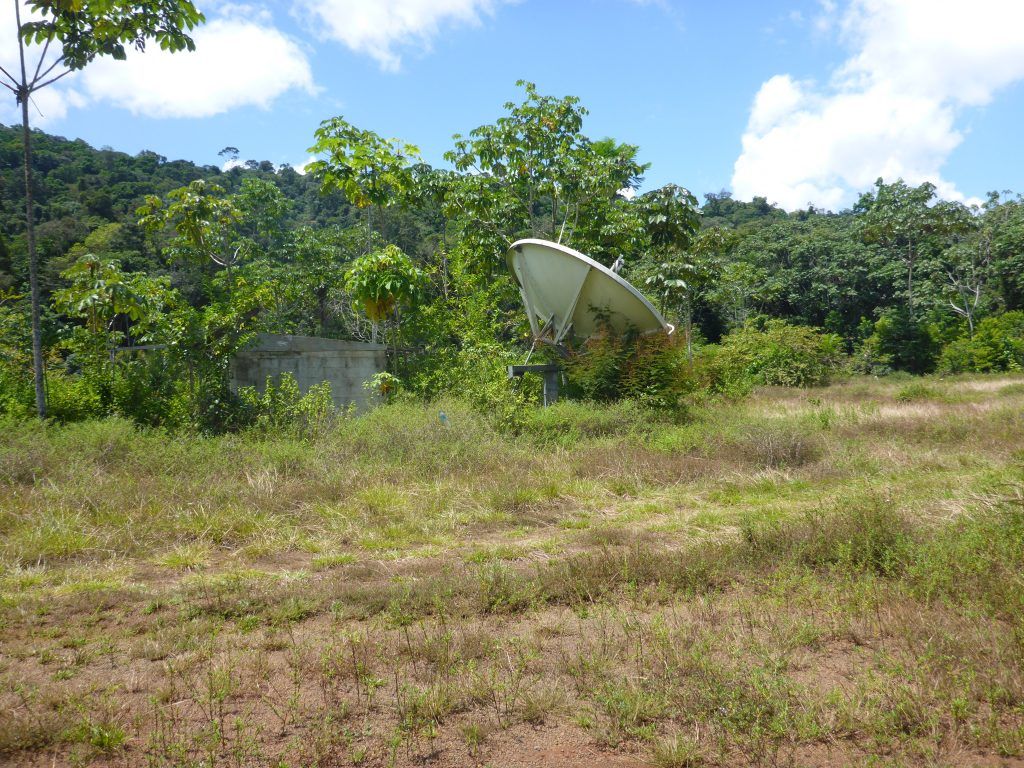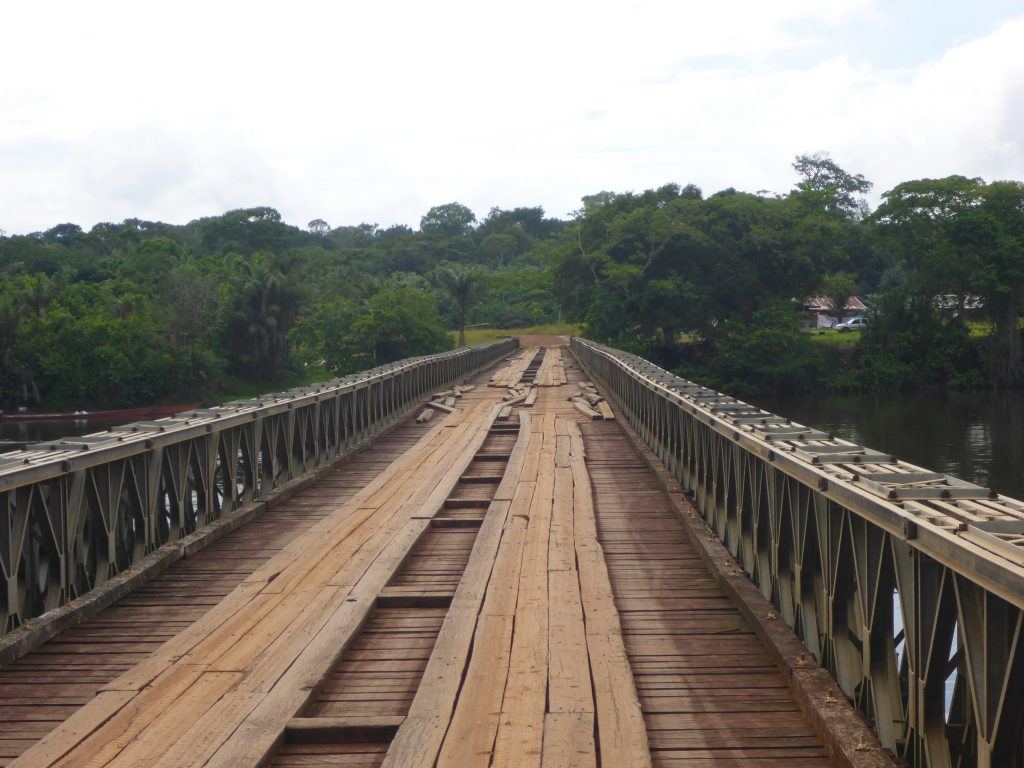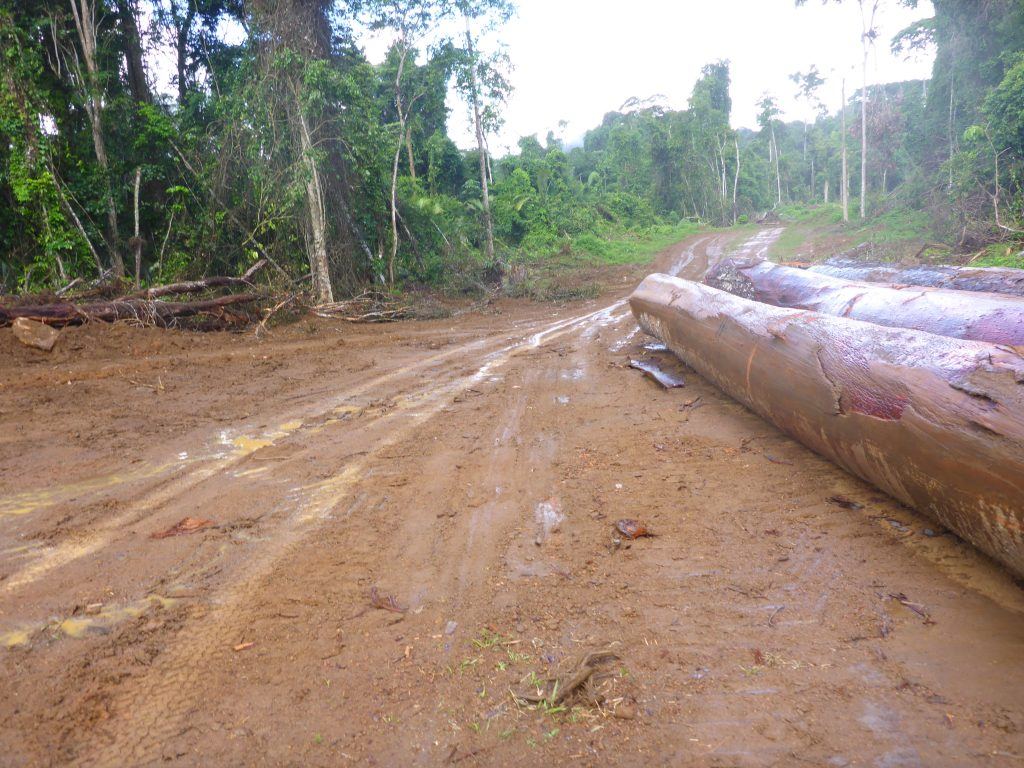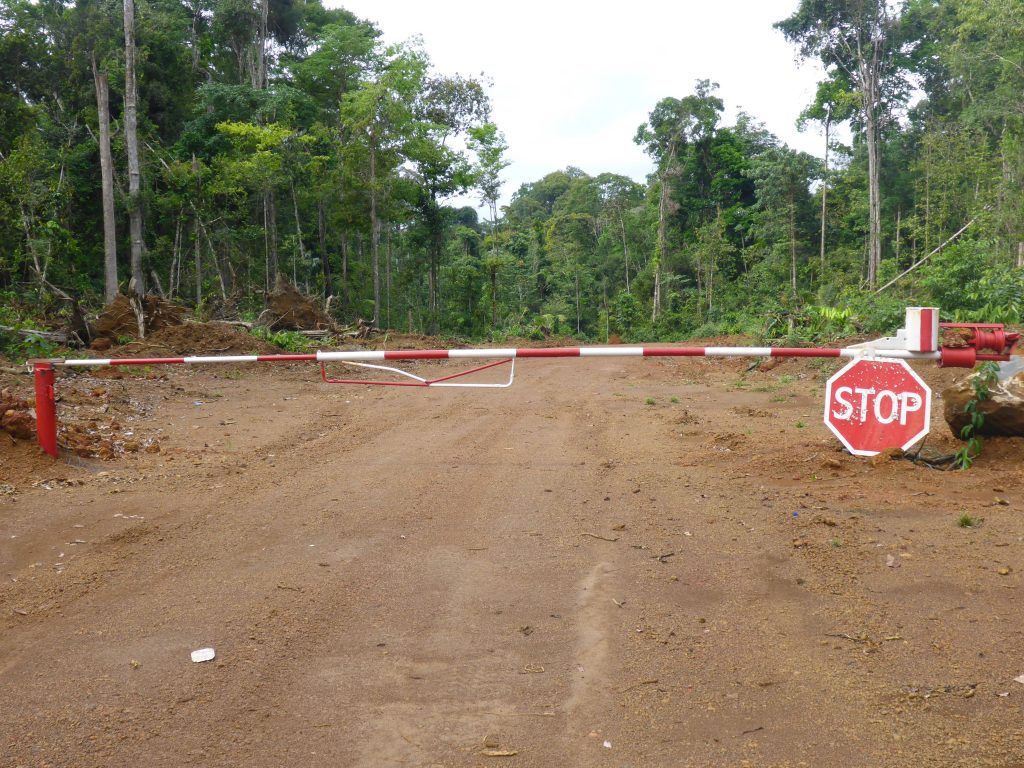As Steve and I drove deeper into the Bakhuis Mountains on a freshly cut track, the canopy closed above us. A large red-footed tortoise slowly crossed the road ahead of us, the third of its kind that we saw since leaving base camp a few hours ago. The truck tires lost traction in the viscous mud as we approached the first makeshift bridge crossing a small stream. Something, a tree branch perhaps, blocked our passage. Good we brought a chainsaw, I thought. As we neared the bridge, we could see this was no branch. A jaguar had awoken from his nap. We stopped; the jaguar raised his head to see what had awakened him. Then, ignoring us, he dropped his head to resume his slumber. He showed no fear as we approached ever closer. We stopped right before him in the middle of the bridge. Neither we nor the jaguar knew what to do because we had never encountered a situation like this in our collective lives.
We watched his body heaving; every exhaled breath was a muffled humph. Apparently, he had just completed his most recent meal and was too bloated to move. Neither horn nor engine caused a reaction. All we could do is watch and wait, not that this was a hardship. Finally, he stood, passed us a parting glance, and moved slowly into the forest. We resumed our journey in silence. Did this really happen?
Twice in 2005, I declined opportunities to work as part of a team of international investigators performing an initial biodiversity assessment for NV BHP Billiton Maatschappij Suriname (BMS) and Suriname Aluminum Company LLC, subsidiaries of BHP Billiton and Alcoa, respectively. They were jointly exploring a bauxite deposit in the Bakhuis Mountains in the Sipaliwini District of Western Suriname. Having run trail cameras in the westernmost area of the Central Suriname Nature Reserve (CSNR) just 15 km east of the Bakhuis Mountains, I thought I knew what the trail cameras would show: not much.
The small community of Raleighvallen in western CSNR is accessible only by small plane using a landing strip cut out of the rain forest, or a tedious river trip. Assigned to protect the western part of CSNR, but without access to supplies such as groceries, the people of Raleighvallen had no choice but to make use of CSNR’s bounty. And make use they did.
Several years previously, using Raleighvallen as my base, I set trail cameras within a two-day travel radius. Following two years of effort, I concluded that either (1) the citizens of Raleighvallen were expert at bush hunting, trapping, and fishing for within my study area very few terrestrial animals had escaped their efforts, or (2) maybe this was typical of what tropical rain forests are like: most of the mammals are arboreal primates. All of Suriname’s eight species of primates were present. But as it turned out, all primates were spared the pot because an international primate research project was underway. Are the terrestrial mammals really this rare? I thought so, but Kent Redford’s 1992 article about what became known as the empty forest syndrome, an intact forest without wildlife, was never far from my thoughts. The answer was revealed during my last visit to Raleighvallen.
I was roused one morning by a commotion the likes of which create violent nightmares. A large herd of white-lipped peccaries, foraging like army ants through the forest, wandered into Raleighvallen. In the half-light of dusk, villagers, despite a late night of partying, grabbed various weapons and descended upon the unsuspecting peccaries as the animals attempted to swim across a stream that was for them too deep to run across, but only thigh-deep for a man. With their arms free, men and women hacked with machetes at the squealing peccaries. The stream ran red as some mortally wounded peccaries floated downstream, while others, wounded, dying, and dead, were dragged ashore. Some tried to stand but could not. Others flopped around on the bank while small piglets ran about in total confusion. I watched from my hammock while the horror show played out.
Nevertheless, I remained skeptical that terrestrial mammals might be naturally rare in tropical forests. When BMS asked if I would be interested in establishing a trail camera monitoring program as part of an environmental impact assessment, I declined, suggesting a colleague who might be interested. He wasn’t. Again, I was contacted and again I declined, suggesting yet another colleague, who also declined. Apparently, everyone knew what I knew: medium-to-large-sized mammals were too rare in tropical forests. But, as it turned out, I was wrong. Very wrong. Bakhuis would show me what an intact, undisturbed tropical forest looked like and change my thinking forever.
I was told by a colleague who was part of the impact assessment team that I should set what I suspected aside and visit Bakhuis with an open mind. In late 2005, I flew on a small plane from Paramaribo, the capital city of Suriname, to a landing strip in the northern Bakhuis Mountains. I was shuttled to a base camp established in the middle of the forest.
Unbeknownst to me then, I was delivered back to a time when animals did not know people, where the forest was pristine, streams crystal clear, and wildlife behaved as naturally as it did before humans set foot in the New World. To say that wildlife was abundant would be an understatement. I was about to explore Eden; the way things were before people arrived. Everything I thought I knew about “pristine” rainforests and wildlife was about to be turned upside-down. My lessons were just beginning; my eyes were opened. I couldn’t get enough.
From 2005 to mid-2008, I visited Bakhuis every three months. Steve and I regularly checked our trail cameras. The number of jaguar individuals continued to increase. We recorded 74 individuals. Several cameras recorded seven jaguars routinely coming and going. Pumas were equally ubiquitous. One strange day, two young pumas followed us through the forest as we checked our cameras, harmless and curious because they had never seen this strange species walking on two legs. Jaguars were the second most common species recorded by our cameras, something that had never been observed anywhere jaguars are found today, and sadly might never been seen again.
We observed a tapir selecting and eating plants, the long nose extending and contracting, seeking just the right leaves to chew. A mother tapir and her calf approached our truck and looked in the passenger window; only a thin window pane separated us. She showed no fear whatsoever. Harpy eagles sat on tree branches, and red-footed tortoises were common along the small forest road network cut by BMS.
Steve checked turbidity meters set in streams to make sure soil was not being carried by run-off from rain. From driving to exploration digs to eating times, all behavior of the workers was strictly controlled. Roads were kept small but clear. Steve and I had access to remote parts of Bakhuis where no exploration took place. Everywhere we went, wildlife was abundant, easily observed, and showed no fear of us. We were working in Eden, a wildlife paradise, the way things once were everywhere on earth, and the way things could be if people chose simply to live with wildlife.
Access to the Bakhuis Mountains was gated and guarded, as required by Suriname law that applied to all mining concessions. These same laws did not apply to logging concessions, however, with tragic consequences. South of the guard gate lay the most pristine wildness paradise I have ever seen on earth. Bauxite exploration was taking place in the most northern part of the mountains, and though the plan was to explore just 6% of the area, the entire 285,000-acre Bakhuis Mountain range was protected, off-limits to everyone but mining company employees and guests like me. Bakhuis was, in fact, better protected than any national park. Though bauxite exploration and mining are well-known to be terribly destructive, BMS was extraordinarily careful not to disturb the streams and wildlife. Our monitoring efforts were rewarded with a global 3rd place corporate award. BMS distributed a calendar with our trail camera pictures to all its offices throughout the world. An awards ceremony was held in Santiago, Chile.
While I was hopeful that BMS would confirm that the Bakhuis bauxite deposits held commercially viable aluminum, others in the environmental community wished the exploratory destruction would stop and the company cease operations. Be careful what you wish for, I warned them. Conservation, after all, requires long-term thinking. In late 2008, BMS determined that the deposits were not commercially viable and decided to abandon the Bakhuis Mountains. Base camp was dismantled. All but the communications dish and a block storage building were removed.
Over the passing years, nature reclaimed what had been lost. But through the environmental impact assessments, the bounty (I detest the phrase “natural resources”) Bakhuis held was made known, if not to the world, then certainly to Suriname residents. It was only a matter of time before this bounty would be reconsidered. Perhaps plundered is a better word.
Following BMS’s withdrawal, try as I might, I failed to convince two international conservation organizations with offices in Suriname that the exceptionally pristine Bakhuis Mountains were worth protecting. Located just west of CSNR that is administered by Conservation International – Suriname, an effort could be made to include Bakhuis under CSNR’s umbrella of protection (if not in reality, then at least on paper). My efforts failed miserably, a failure as alive in me today as it was in 2009.
In August, 2019 Steve and I, accompanied by a friend, returned to Bakhuis. The drive west from Paramaribo over mostly unimproved roads and a dilapidated bridge across the Coppename River took eight hours.
We found the old Bakhuis sign still standing. A road into Eden was open.
As we drove along the newly widened road, we recalled how the road once was. It’s always repeated that tortoises are the first to go. I can confirm this is true. We did observe red-footed tortoises, but not along the road.
A logging concession operated by Woody Wood NV was now in full operation. Destructive logging was ravaging Bakhuis. Heavy equipment, like bulldozers, front-end loaders, and tree haulers were enlarging old tracks, pushing new roads into what had previously been undisturbed pristine rain forest and hauling out timber. Valuable trees were hunted down by Pacman-like bulldozers that let nothing stand in their path. Filipino tree spotters with GPS units and shotguns roamed the forest marking the next stationary victims and shooting mobile species. Next to their dilapidated quarters, whose roofs were covered by plastic sheets, was a pen of red-footed tortoises, living canned food to be eaten as desired.
Later in the day, vacationing hunters in their SUVs were arriving early for a long weekend of killing, no license required, and no guard gate to stop them. With wildlife showing no fear of people, and night-spotting from vehicles made easy, Bakhuis had become a choice hunting destination. We were informed by several hunters that jaguar and ocelot were high-value targets due to the value placed on their spotted skins. Using a simple jaguar caller (a drum-like hollow tube, one opening covered with leather and a leather string through the cover that is slowly jerked to vibrate the drum cover), jaguars were easy to call in and kill. Tapirs were also high value meat, but anything with eye-shine was fair game.
The Bakhuis I knew a decade ago was gone. Paraphrasing Alfred Tennyson:
‘Tis better to have known Bakhuis and lost it, than to have never known it at all.
But the burden is a heavy one, for not a day passes that I do not think about what I, what the people of Suriname, what citizens of earth, have lost. But maybe this view is short-sighted. Perhaps there is a way forward, if not to turn back the calendar, but to realize a brighter, safer future.
BMS and another global aluminum company, Suralco (Alcoa in Suriname), have vacated Suriname. Apparently, the bauxite deposits are not commercially viable, but other geological deposits might be. A sign pointed to the gated entry of Wintrip NV, indicating a mining concession.
The modus operandi of logging companies is to remove as much valuable timber as fast as possible. Before any required replanting is done, the company usually declares bankruptcy. I cannot speculate about Woody Woods NV’s lifetime in Bakhuis. All of Bakhuis that can be reached by bulldozer will be penetrated and ravaged. The Filipino employees and independent hunters will do a lot of killing. But not all the trees and not all the wildlife will be taken. Nature acts long-term.
The coming years provide a window of opportunity to plan and realize a brighter future that includes full protection for Bakhuis and its surviving wildlife. Given half a chance, wild nature will return. The last decade-long window was wasted, but perhaps nothing could have been done because astute Suriname businessmen and politicians realized Bakhuis held profitable timber and perhaps gold or diamonds. When extraction stops and Wintrip and Woody Wood depart, conservationists should be prepared to act decisively in cooperation with a local NGO that cannot be booted out of their home country.


